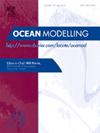推进多尺度波浪模拟:2022年大西洋飓风季节的全球和沿海应用
IF 2.9
3区 地球科学
Q2 METEOROLOGY & ATMOSPHERIC SCIENCES
引用次数: 0
摘要
以2022年6个月的飓风季节为例研究和波谱波模型WAVEWATCH III,这项工作表明,通过变分辨率全球网格(5-30公里)产生的波浪参数与各种验证观测数据集一致,其水平与恒分辨率网格(3公里)相当,后者的运行成本高出6倍。优化后的可变分辨率、非结构化三角形网格忠实于陆地几何形状和波浪变换梯度,同时在梯度通常不太明显的较深区域放松焦点。通过卫星测高、固定浮标网络和漂流浮标测量的波浪参数不仅证明了在粗糙、恒定分辨率网格(40 km)上的性能大幅提高,RMSE从0.28 m降至0.14 m,相关系数(CC)从0.92提高到0.98,而且性能水平与经过完全收敛分析的网格相当。与浅层区域和气旋风暴附近的性能比较突出了解决相关几何形状的重要性。近岸数据RMSE从0.29 m提高到0.13 m, CC从0.89提高到0.98;浅层RMSE为0.29 ~ 0.15 m, CC为0.88 ~ 0.97;气旋条件下RMSE为0.62 ~ 0.35 m, CC为0.93 ~ 0.98。进一步分析了使用变分辨率网格的波浪模型结果,以提供研究区六个月研究期间波浪气候的详细总结,包括风浪和涌浪分区。本文章由计算机程序翻译,如有差异,请以英文原文为准。
Advancing multi-scale wave modeling: Global and coastal applications during the 2022 Atlantic hurricane season
Using the six-month hurricane season of 2022 as a case study and the spectral wave model WAVEWATCH III, this effort shows that wave parameters produced via a variable-resolution global mesh (5–30 km) agree with a diverse array of validating observational datasets at a level comparable to that of a constant-resolution mesh (3 km) that is six times more costly to run. The optimized variable-resolution, unstructured triangular mesh is faithful to land geometry and wave transformation gradients while relaxing focus in deeper regions where gradients are typically less pronounced. Wave parameters measured via satellite altimetry, stationary buoy networks, and drifting buoys are employed to demonstrate not only a substantial increase in performance over a coarse, constant-resolution grid (40 km), with RMSE reduced from 0.28 m to 0.14 m and Correlation Coefficient (CC) improved from 0.92 to 0.98 overall, but also a comparable level of performance to that of a mesh that has undergone a full convergence analysis. Performance comparisons isolated to shallow regions and near cyclonic storms highlight the importance of resolving relevant geometries. For nearshore data, RMSE improves from 0.29 m to 0.13 m and CC from 0.89 to 0.98; in shallow regions, RMSE from 0.29 m to 0.15 m and CC from 0.88 to 0.97; and under cyclonic conditions, RMSE from 0.62 m to 0.35 m and CC from 0.93 to 0.98. Wave model results using the variable-resolution mesh were further analyzed to provide a detailed summary of the wave climate, including wind-wave and swell partitions, over the six-month study period in the study area.
求助全文
通过发布文献求助,成功后即可免费获取论文全文。
去求助
来源期刊

Ocean Modelling
地学-海洋学
CiteScore
5.50
自引率
9.40%
发文量
86
审稿时长
19.6 weeks
期刊介绍:
The main objective of Ocean Modelling is to provide rapid communication between those interested in ocean modelling, whether through direct observation, or through analytical, numerical or laboratory models, and including interactions between physical and biogeochemical or biological phenomena. Because of the intimate links between ocean and atmosphere, involvement of scientists interested in influences of either medium on the other is welcome. The journal has a wide scope and includes ocean-atmosphere interaction in various forms as well as pure ocean results. In addition to primary peer-reviewed papers, the journal provides review papers, preliminary communications, and discussions.
 求助内容:
求助内容: 应助结果提醒方式:
应助结果提醒方式:


